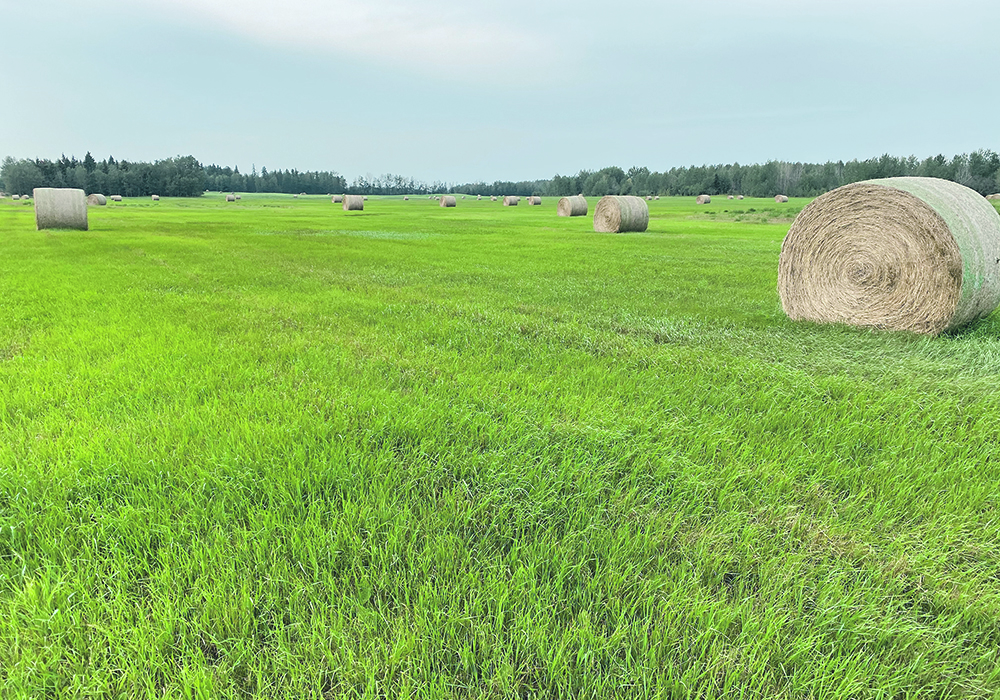Eastern hay arrives on western Canadian farms

Prairie producers breathe easier as Canadian Federation of Agriculture’s Hay West program begins delivering the goods
Ken Overby is breathing easier.
This week, the fifth and final trailer load of round bales was unloaded at his 400-head bison ranch near Inwood, Man.
The 190 round bales are part of Hay West 2021, a relief program operated by the Canadian Federation of Agriculture that is working with farmers across Atlantic and Eastern Canada to provide hay to drought-stricken western livestock producers.
“It’s a good program and it’s very welcome. I applaud the people who put it together and all the efforts that they’ve gone to,” Overby said by phone.
The supplied hay gives more options, but he will still have to cull heavier than normal and sell some stock.
“We’re going to have zero stockpiled grass for next spring. I’m going to be saving that hay for spring feeding at calving time. The Hay West program allows us to calve out the cows and have some fairly decent feed for them at that time rather than just straw,” he said.
CFA president Mary Robinson said many eastern Canadian producers, particularly in Ontario and Quebec, are donating after a bumper hay harvest this summer, not forgetting the generosity of western farmers during the Hay East program of 2012.
“They remember not only how important it was for their livestock operations, but also just how great it felt to have a farmer in Western Canada care enough to send hay.”
Robinson said about 40,000 bales of hay have been pledged or donated by suppliers in P.E.I., New Brunswick, Nova Scotia, Quebec and Ontario, with more on the way.
Producers must meet certain conditions to qualify for hay. The feed is being prioritized for those who have breeding herds and access to water.
Losing breeding stock will have a negative impact on the national herd into the future, said Robinson.
With the shortage estimated at four million tonnes of hay across the three prairie provinces, she said geography and cost of freight will limit the amount of help they can provide.
“We’re not going to run out of people wanting hay. We’re going to either run out of hay or run out of money to send it first. So, we’ll just keep sending it as long as we can,” she said.
The program focuses on the areas hardest hit by the drought.
“We’re trying to be strategic and get as much hay as possible to the places that (need it), so we’re taking cues, working with the Canadian Cattlemen’s Association, as well as Keystone Agricultural Producers, APAS (Agricultural Producers Association of Saskatchewan) and Alberta Federation (of Agriculture) — anyone who wants to work with us to figure out how to do this the best way possible,” she said.
Hay West 2021 is operating on a break-even basis with hay purchased from eastern Canada suppliers and resold at cost to recipients.
The price is 10 cents per pound for all hay supplied. Round and large square bales of varying weights and sizes will be supplied as available. Selected applicants will be contacted for distribution dates and payment.
“We take that money and put it towards freight for more hay so that we’re trying to keep it equitable across the board for everybody that received hay,” Robinson said.
Of the tens of thousands of bales pledged, about 1,000 have been delivered, mostly to Manitoba, which was hard hit by drought this summer.
“We’ve secured some funding to offset freight costs and we’re continuing to seek out more funding. So long as we can find funding for freight, I think we’re going to be able to continue with this program until there’s no more hay to move,” she said.
Anyone wanting to sell, donate or apply for hay should visit haywest2021.net and follow the prompts. Inquiries can be directed to info@haywest2021.net.
For more content related to drought management visit The Dry Times, where you can find a collection of stories from our family of publications as well as links to external resources to support your decisions through these difficult times.
Source: www.producer.com


